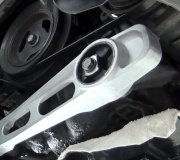Hi sunday_blitz. Welcome to the forum. You're looking at this circuit the wrong way. The inlet air temperature sensor, knock sensor, throttle position sensor, MAP sensor, camshaft position sensor, and coolant temperature sensor all have separate circuits, but they all share a common ground wire. That's the black wire with a light blue stripe.
Both of these temperature sensors have an extremely low failure rate. To have a fault code, and two of them at that, it is more likely they were set while other testing was being done. The 5.0 volt supply from the Engine Computer has to be working because it is needed to set a "voltage high" code that you got for the air temperature sensor. Unplugging that sensor while the ignition switch is on, a break in the wire to that sensor, or a loose connector will set that code.
To check that circuit, use a voltmeter to measure the voltage on that violet / light green wire. With the connector unplugged, you should measure 5.0 volts. With it plugged in and and by back-probing that wire, you must read between.5 and 4.5 volts. The higher the temperature, the lower will be the voltage. Expect to see around 2.5 volts.
To set the fault code for the coolant temperature sensor reading too low, the wire would have had to be grounded. You can measure that circuit the same way. There will be 5.0 volts on the tan / black wire when the sensor is disconnected, and when connected and back-probed, it must also read between.5 and 4.5 volts. Voltages outside those limits is what the computer uses to observe a problem and set a code.
I won't say the Engine Computer CAN'T cause your problem, but it is very unlikely because if the 5.0 volt supply was dead, there would be fault codes for the TPS and MAP sensors too. Of course the two sensors you're dealing with get their voltage through different pins in the computer's connector than the TPS and MAP, but to have two circuits with a problem is very unlikely. The camshaft position sensor wouldn't work either if the 5.0 volts was missing so the engine wouldn't run.
Besides the fault codes, what are the symptoms? What do you mean by IAT "adapter"? Do you mean the connector?
Caradiodoc
Thursday, June 17th, 2010 AT 2:36 AM


